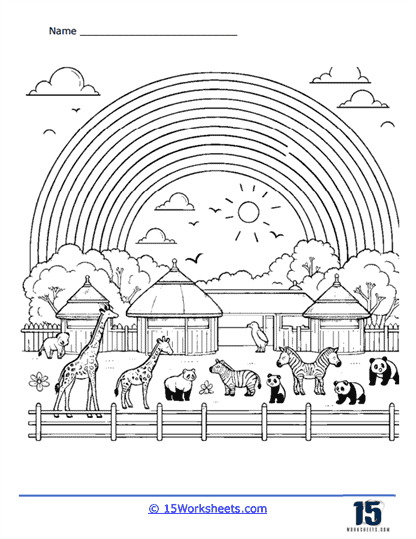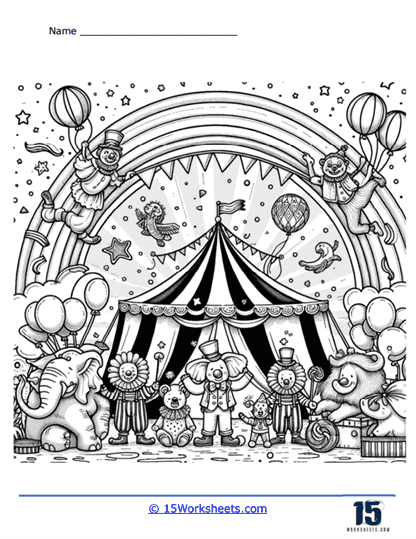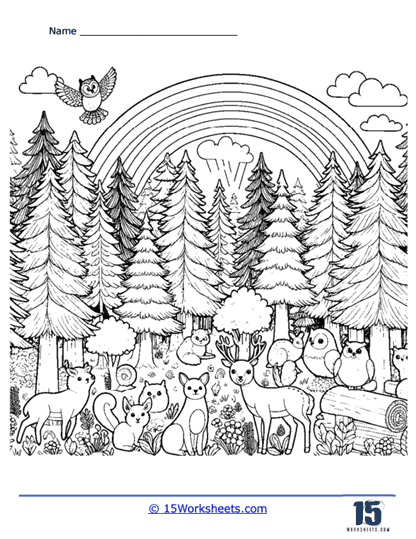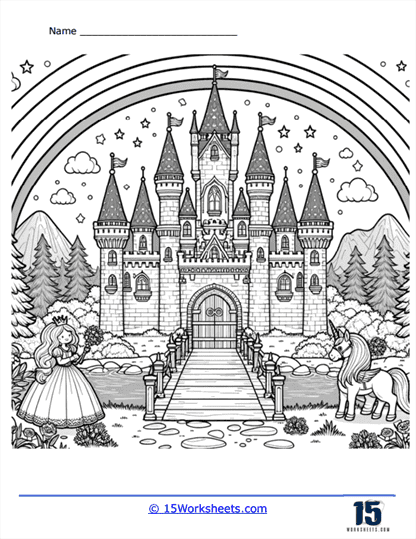Rainbow Worksheets
About These 15 Worksheets
Rainbow coloring pages are an engaging and vibrant form of creative expression, particularly popular among children but also enjoyed by adults as a stress-relief activity. These pages are typically black-and-white illustrations featuring a variety of themes and designs that are intended to be filled in with a spectrum of colors, often inspired by the rainbow’s array of hues.
Different Themes and Designs
1. Traditional Rainbows
Traditional rainbow coloring pages feature the iconic arc of colors, usually starting with red and ending with violet. These pages might depict a simple rainbow across a plain sky or integrate the rainbow into a more complex scene, such as a landscape with hills, clouds, and a pot of gold at the end. The colors of the rainbow – red, orange, yellow, green, blue, indigo, and violet – provide a guide for those coloring, but there’s room for creativity in adding patterns or additional details.
2. Fantasy and Magical Creatures
Many rainbow coloring pages incorporate elements of fantasy, including unicorns, fairies, dragons, and magical forests. Unicorns, in particular, are a favorite subject, often depicted with manes and tails that can be colored in rainbow shades. Fairies might have rainbow wings, and dragons could have scales that span the spectrum of colors. Magical forests might include rainbow-colored plants, mushrooms, and streams, offering endless possibilities for vibrant and imaginative coloring.
3. Nature and Landscapes
Nature-themed rainbow coloring pages often include elements such as flowers, trees, birds, and animals. These pages might feature scenes where rainbows appear in the sky over mountains, meadows, or oceans. Flowers and butterflies are particularly popular subjects, as they can be colored with an array of bright, rainbow-inspired hues. Animals like peacocks, parrots, and fish can also be illustrated with elaborate patterns that invite the use of a wide range of colors.
4. Abstract and Geometric Designs
Abstract and geometric designs are common in rainbow coloring pages. These pages might include mandalas, intricate patterns, and shapes that can be filled with a variety of colors. These designs often focus on symmetry and repetition, providing a meditative and relaxing coloring experience. The use of rainbow colors in these patterns can create visually striking and harmonious images.
5. Educational and Informative
Some rainbow coloring pages are designed with educational purposes in mind. These pages might include diagrams of rainbows with labels for each color, explanations of how rainbows form, and other scientific information. They can also feature alphabets, numbers, and shapes that children can color in, making learning a fun and colorful activity. Additionally, pages featuring maps, flags, and historical figures can be designed to incorporate rainbow colors, providing a creative way to engage with educational content.
6. Pop Culture and Modern Themes
Pop culture and modern themes also make their way into rainbow coloring pages. This can include popular characters from movies, TV shows, and books, all reimagined with rainbow elements. Superheroes might have rainbow-colored costumes, and famous landmarks could be illustrated in a way that invites colorful interpretation. These pages can also feature trendy designs and motifs such as rainbows paired with motivational quotes, emojis, and other contemporary symbols.
The Benefits and Appeal
Encouraging Creativity
Rainbow coloring pages are a fantastic way to encourage creativity. The use of a wide range of colors allows for imaginative expression, and the diverse themes provide endless opportunities for creative exploration. Whether it’s deciding which colors to use for a unicorn’s mane or how to fill in a complex geometric pattern, these pages stimulate creative thinking and artistic skills.
Stress Relief and Relaxation
For both children and adults, coloring can be a calming and meditative activity. The repetitive motion of coloring within the lines, combined with the focus on choosing and applying colors, can help reduce stress and promote relaxation. The bright, cheerful colors associated with rainbows can have a particularly uplifting effect on mood.
Educational Value
As mentioned, rainbow coloring pages can have educational elements. They can teach children about colors, patterns, and the natural phenomenon of rainbows. Pages designed with educational content can also make learning more engaging and interactive. For example, coloring a diagram of a rainbow can help reinforce the order of colors and the science behind how rainbows are formed.
Motor Skills Development
Coloring within the lines of rainbow coloring pages can help develop fine motor skills, hand-eye coordination, and concentration. For young children, this activity is particularly beneficial as it helps with the development of the muscles in their hands and fingers, which are essential for writing and other tasks.
Social Interaction
Rainbow coloring pages can also be a social activity. Children might work together on coloring pages, sharing ideas and discussing their choices. Group coloring sessions can foster teamwork and communication skills. For adults, coloring clubs and groups provide a social outlet and a shared creative experience.
Types of Tools and Materials
To fully enjoy rainbow coloring pages, a variety of tools and materials can be used:
Colored Pencils
Colored pencils offer precision and control, making them ideal for detailed areas and intricate designs. They come in a wide range of colors, including many shades within each hue of the rainbow.
Markers and Crayons
Markers are great for bold, vibrant colors. They are particularly useful for larger areas that need to be filled quickly. Fine-tip markers can be used for detailed work, while broad-tip markers are perfect for bigger sections.
Crayons are a classic choice for coloring pages, especially for younger children. They are easy to use and come in a vast array of colors. The texture of crayons can also add a unique effect to the colored pages.
Watercolors and Paints
For a more artistic approach, watercolors and other types of paints can be used. This allows for blending and mixing colors, creating gradients and more complex color schemes. This method might be more suitable for older children and adults who are looking for a different way to engage with their coloring pages.















